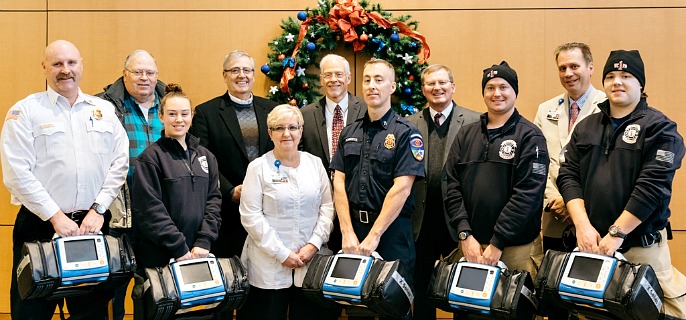
PHOTO COURTESY OF GSHCS
On Monday, Dec. 12, Umatilla County Fire District #1 (UCFD1) received an early present of five monitor and defibrillator combos with an additional $15,000 donation from the Good Shepherd Community Health Foundation toward the purchase of a sixth monitor in the future.
The new monitors were a contribution by Good Shepherd Health Care System (GSHCS) and cost approximately $32,000 each.
“These monitors will help ensure a high-level of continuity in the care we are able to provide for our community,” said GSHCS President and Chief Executive Officer Dennis Burke. “When a first responder uses a monitor it can be linked directly to the emergency room giving our physicians an opportunity to make an informed decision about the patient and the appropriate care they should receive upon arrival. It will also help EMS and physicians make decisions on where patients should go for treatment – if a more invasive course of action is determined.”
The fire district will use these new monitors to replace a mix and match array of monitors that they are currently using. This will also ensure that each EMS responder will be trained on the same device and not have to worry about learning the unique intricacies of using multiple devices.
Cpt. JW Roberts, EMS Coordinator with UCFD1 said, “Being able to have all monitors the exact same is an enormous advantage,” said Cpt. JW Roberts, EMS coordinator for the district. “Crews will only need to be proficient on a single machine no matter which unit they are responding on, significantly reducing the potential for errors while simplifying training. Additionally, these new monitors are the same brand that GSHCS uses. Having compatibility with GSHCS is great because we drop off and pick up patients thousands of times a year, occasionally with GSHCS employees going on transports with us!”
Features of the new monitors include diagnostic tools which have the ability to detect STEMI (heart attack), respiratory issues, and other potential issues with patients. These are very important in time-sensitive emergencies where the patient can be transported appropriately, and data can be sent to the emergency room physician for a consultation. The monitors will get quick, accurate vital signs which are required for all patients. They will coach the crews on high-quality ventilations and chest compressions. These monitors will immediately show airway status, as well as breathing status and issues. The SpCO function will be able to detect carbon monoxide poisonings in any patient, and routinely be used to ensure that firefighters are not being overexposed to smoke. The new monitors will continue to provide the required automatic defibrillation and interpretive diagnosis so that any level of EMS provider can use the machine, similar to an AED.









